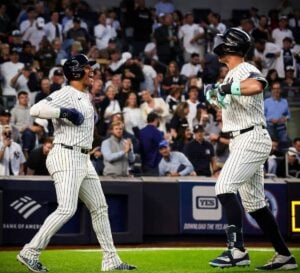Wally Pipp: Two-time AL home-run leader who Lou Gehrig replaced in Yankees lineup

Esteban Quiñones
More Stories By Esteban Quiñones
- Mother’s Day: How Anthony Volpe’s mom molded him into a Yankee phenom
- Yankees 6-5 Royals: Alex Verdugo’s late heroics propel Bronx Bombers to ALDS-opening win
- Alex Verdugo leads Yankees comeback with key hit and stellar defense vs. Royals
- Gerrit Cole struggles early as Yankees trail Royals in ALDS opener
- Boone leans on Cabrera’s versatility, Verdugo’s experience for Yankees’ ALDS opener
Table of Contents
The Profile
| Position | First Baseman |
| Active years | 1913 – 1928 |
| Teams (years) | Detroit Tigers (1913) New York Yankees (1915–1925) Cincinnati Reds (1926–1928) |
| Debut | June 29, 1913, for the Detroit Tigers |
| Last game | September 30, 1928, for the Cincinnati Reds |
| Date of Birth | February 17, 1893 |
| Native place | Chicago, Illinois, U.S. |
| Batted | Left |
| Threw | Left |
| World Champions | World Series champion (1923) |
| MLB Awards | 2× AL home run leader (1916, 1917) |
| AL Triples Leader (1924) | |
| 5x AL Putouts Leader (1915, 1919, 1920, 1922, 1926) | |
| Legacy | Grand Rapids Sports Hall of Fame |
| Nickname | “Wally” |
Wally Pipp is remembered as the player who Lou Gehrig replaced as the Yankees’ first baseman. His headache on June 2, 1925, left a historical consequence for the Yankees. As he opted out of the game, manager Miller Huggins entrusted a rookie first baseman, who had garnered acclaim at Columbia University, to fill in for Pipp.
The talented rookie, Lou Gehrig, swiftly established himself in the position and went on to occupy the role of the Yankees’ first baseman for an astounding 2,130 consecutive games, setting a record that stood for nearly six decades. Wally Pipp was not able to have a chance to come back.
Lou Gehrig, who earned the nickname “The Iron Horse,” displayed remarkable durability by not sitting out a single game until 1939 when he had to retire due to his struggle with amyotrophic lateral sclerosis (ALS). Even now, in the realm of baseball, references to Wally Pipp are made when a seasoned player is replaced in the starting lineup. Certain sportswriters have audaciously transformed “Pipped” into a verb to describe such a situation.
Who was Wally Pipp?

Wally Pipp was much more than just a historical footnote. He was a power hitter who led the American League twice in home runs. The Grand Rapids native was also an architect, a writer, and a mentor.
The history of Major League Baseball (MLB) would be incomplete without mentioning his name, just as the story of Grand Rapids would be incomplete without acknowledging him as one of its revered sports figures.
Walter Clement Pipp, born on February 17, 1893, in Chicago, came from a Catholic family. His mother, Pauline (Stroeber) Pipp, had German heritage, while his father, William H. Pipp, was described as either Irish or German, depending on different sources. William Pipp was a respected homebuilder and architect, who ensured a comfortable life for his family.
When Wally Pipp was 2 years old, his family relocated to Grand Rapids, where they settled for several generations. Interestingly, Wally’s uncle, Henry Pipp, had a career in professional baseball, playing for the Chicago Nationals, which eventually became the present-day Chicago Cubs, in the late 19th century.
From a young age, Wally Pipp displayed a natural inclination for sports, engaging in football during the fall, hockey during the winter, and baseball during the spring. Unfortunately, as a teenager, he suffered a blow to the head from a hockey puck, resulting in lifelong headaches and partial hearing loss in his right ear. Nevertheless, Wally Pipp’s physical growth led him to reach an impressive height of 6’3″ with broad shoulders. At Catholic Central High School in Grand Rapids, he stood out as an exceptional athlete, surpassing his peers in both skill and stature. It’s worth noting that although the school has produced numerous NFL players, Pipp remains the only MLB player to emerge from its ranks.
The early career
With his commitment to academics, Wally Pipp pursued further education at Catholic University in Washington, D.C. During his time there, he distinguished himself as a remarkable player on the Cardinals’ baseball team. It’s worth noting that in the early 20th century, it was uncommon for major league players to have a college background, making him a rarity among his peers. Following in the footsteps of his family’s profession, he delved into the field of architecture and successfully obtained his bachelor’s degree in 1912.
In 1915, Wally Pipp entered the Major League Baseball (MLB) scene. Prior to that, he had showcased his exceptional talents in various minor league teams including Kalamazoo, Providence, Scranton, and Rochester for a span of three seasons. Interestingly, the Detroit Tigers initially held his MLB rights but questioned his defensive abilities, a doubt that would later be proven completely unfounded. Consequently, they sold his rights to the Yankees for $5,000 in January 1915. As history would reveal, this seemingly modest investment turned out to be a remarkably wise move by the struggling Yankees at the time.
As soon as Wally Pipp joined the New York team, he assumed the role of their regular first baseman. Despite being a rookie, he showcased remarkable defensive skills and a strong hitting ability. His power at the plate was particularly impressive considering the era in which he played, known as the “dead ball era.” This term was coined due to the construction of baseballs at the time, where the core yarn was less tightly wrapped compared to modern baseballs. Consequently, players faced challenges in hitting the ball as hard and as far as they do today. Wally Pipp’s ability to generate significant power during this era was a genuine accomplishment.
Wally Pipp achieved notable success as he led the American League (AL) in home runs during the 1916 and 1917 seasons. In 1916, he hit 12 home runs, and in 1917, he hit 9 home runs. The 1916 season marked a significant milestone for the Yankees, as it was their first winning season since 1910 when the team was known as the Highlanders. Wally Pipp’s speed and agility allowed him to hit several in-the-park home runs during each season, taking advantage of his remarkable swiftness. Throughout his career, Wally Pipp accomplished the rare feat of hitting at least 10 triples in a season on seven different occasions, which is uncommon in today’s game. In 1924, he led the AL in triples with an impressive total of 19.

A Yankees hero
Following his service in World War I, Wally Pipp rejoined the Yankees in 1919 and played a vital role in the team’s successful season, contributing to their impressive 80-59 record. However, in terms of home runs, Wally Pipp finished second that year to an unexpected source, a Red Sox player named Babe Ruth. Ruth’s remarkable tally of 29 home runs far surpassed Pipp’s modest total of seven. It was in the following year, 1920, that Ruth and Wally Pipp would become teammates, marking the beginning of a legendary era in Yankees history.
In a historic move, the Red Sox made the decision to sell Ruth to the New York Yankees for a staggering sum of $125,000. This transaction marked the beginning of what would become known as the “Curse of the Bambino,” a period of championship drought for the Red Sox, while simultaneously ushering in an era of unprecedented success for the Yankees. The Yankees would go on to establish themselves as the most accomplished franchise in the history of professional sports.
When Babe Ruth joined the New York Yankees, it coincided with the introduction of a new type of baseball known as the “live ball” in Major League Baseball. This new ball was wound tighter, resulting in enhanced offensive performance. Ruth took full advantage of this change and revolutionized the game’s offensive records in the early 1920s. In the years 1920 and 1921, he astonished the baseball world by hitting an incredible 54 and 59 home runs respectively, setting new benchmarks for power hitting.
However, Wally Pipp continued to excel as one of the top hitters in the American League. In the 1921 season, he played a crucial role in the heart of the Yankees’ lineup alongside Bob Muesel and Babe Ruth. Wally Pipp himself drove in 103 runs, while Muesel and Ruth had impressive totals of 138 and 168 RBIs respectively. With their offensive prowess, the Yankees secured their first American League pennant, although they ultimately fell short in the World Series against their crosstown rivals, the New York Giants. It is worth noting that Wally Pipp and Ruth had a relationship that, at times, experienced disagreements and tensions.
When Wally Pipp confronted Ruth
Ruth and Wally Pipp had a notable incident in the dugout when Ruth criticized him for making an error at first base. In response, Wally Pipp confronted Ruth with determination, indicating that they would resolve the issue after the game. It seems that Ruth backed down from further confrontation. Despite this incident, their relationship remained amicable enough for Wally Pipp to work as a ghostwriter for Ruth. Wally Pipp assisted Ruth in writing columns that the renowned slugger was obligated to contribute to various national publications, thereby earning some extra income.
The Yankees experienced another defeat against the Giants in the 1922 World Series, repeating the previous year’s outcome. However, in 1923, they finally achieved victory over their crosstown rivals in the Fall Classic, putting an end to their string of losses. As the Yankees’ roster gradually became younger, Wally Pipp continued to be a dependable player, contributing to the team’s success. He drove in more than 100 runs in both 1923 and 1924, a notable accomplishment, even though the Yankees finished as runners-up in 1924.
Wally Pipp faced difficulties at the beginning of the 1925 season, and his performance was not up to par. His early June headache became the turning point that led to Lou Gehrig’s rise as the team’s first baseman, a change that was likely to happen sooner or later.
The 22-year-old Lou Gehrig had showcased his skills in the minor leagues for the past two seasons and it was only a matter of time before he made his mark in the Major Leagues. Although Wally Pipp lost his starting job, he maintained a friendly relationship with the young Lou Gehrig and took on the role of mentoring him in the intricacies of playing the position. Even after Wally Pipp retired, he and his sons had a pleasant encounter with Lou Gehrig after a game in Detroit, engaging in a warm conversation like old friends reunited.
Wally Pipp left New York
In 1926, Wally Pipp was traded by the New York Yankees to the Cincinnati Reds of the National League, marking the final chapter of his Major League Baseball career. Despite reaching his mid-30s, Wally Pipp remained a dependable player during his time with the Reds. He decided to retire at the age of 35, leaving behind a respectable legacy with a career batting average of .281, 90 home runs, and 1,004 runs batted in (RBIs).
Wally Pipp stood out as a remarkable player who thrived in both the “dead” and “live” ball eras of baseball, although he had a clear preference for the former. He shared his insights about the game through writing for various publications and dedicated several decades to teaching young players in Grand Rapids. Throughout his career, Wally Pipp emphasized the importance of “small ball,” a strategy focused on fundamental skills and teamwork.
A torch bearer for baseball
Wally Pipp held the belief that baseball had lost a significant amount of finesse, strategy, and psychological elements due to the heavy reliance on power hitters and home runs for offense. He saw baseball as a sport that thrived on the intricacies of bunts, hit-and-run plays, and stolen bases.
After his retirement from professional baseball, Wally Pipp decided to focus on his life in Grand Rapids. He settled down with his wife Nora and together they raised a family of four children, consisting of three boys and a girl. They became active members of St. Stephen’s Catholic Church in East Grand Rapids, where they attended services and participated in the community.
After his baseball career, Wally Pipp ventured into the field of finance and worked as a stockbroker. He also pursued his passion for writing and authored a book titled “Buying Cheap and Selling Dear,” which focused on stock market strategy. Additionally, Wally Pipp found work as a pregame radio broadcaster for the Detroit Tigers and contributed to writing copy for various radio stations in Michigan. In his leisure time, Pipp became an avid golfer, joining the Highland Country Club and playing several rounds each week. His dedication paid off, as within a couple of years, he consistently achieved scores in the 70s during his golf outings.
During the challenging period of the Great Depression, Wally Pipp sought employment with the National Youth Administration (NYA), an agency established as part of the New Deal initiatives. The NYA aimed to support and empower young individuals by offering them opportunities for work and education.
Wally Pipp’s dedication to baseball continued to shine through in his work with the National Youth Administration. Naturally drawn to the sport he loved, he took on the responsibility of organizing community baseball leagues not just in Grand Rapids but also throughout the Midwest. This marked the beginning of a long-lasting passion for the former major league player, as he devoted himself to nurturing and fostering the game among young athletes in the region for many years to come.
For a long time, Wally Pipp had been a strong proponent of establishing youth baseball leagues and dedicated a considerable amount of time to such organizations when they were introduced in Grand Rapids. He actively participated in working with players from Little League, Pony League, and American Legion, offering his guidance and expertise to young athletes in the area for many years.
Wally Pipp was also a vocal supporter of gender equality in baseball and expressed his belief in the early 1950s that women would eventually have the opportunity to play in Major League Baseball.
Wally Pip’s Aspirin Paved the Path for Lou Gehrig
Wally Pipp’s infamous headache on June 2, 1925, may have been the most consequential headache in baseball history. At that pivotal moment, the New York Yankees’ starting first baseman sought relief from his ailment, and little did he know that this seemingly ordinary request for two aspirin would alter the course of baseball history.
Manager Miller Huggins, noticing Pipp’s discomfort, made a fateful decision: “Wally, take the day off. We’ll try that kid Gehrig at first today and get you back in there tomorrow.” Little did anyone know that this moment would become the catalyst for one of the most enduring records in baseball – Lou Gehrig’s consecutive games played streak.
Credits: Fox News
On that Tuesday afternoon at Yankee Stadium, 21-year-old Lou Gehrig, the man who would become a baseball immortal, took Pipp’s place at first base. Gehrig seized the opportunity, delivering an impressive performance with three hits and scoring a run in the Yankees’ 8-5 victory over the Washington Senators. Although officially, Gehrig’s consecutive games streak began the day before with a pinch-hitting appearance, it was Wally Pipp’s headache that truly paved the way for Gehrig as the Yankees’ starting first baseman.
The following day, Gehrig initially went hitless, and Pipp briefly returned to first base. However, on June 5 against the Browns, Gehrig smashed his first home run of the season, marking the beginning of a legendary career. By the time Gehrig left the Yankees’ lineup in 1939 due to amyotrophic lateral sclerosis (ALS), he had left an indelible mark with 2,721 hits, 493 home runs, 1,995 RBIs, two MVP awards, and six World Series titles.
In contrast, Wally Pipp’s career took a different trajectory. Despite playing 15 seasons in the big leagues, he was sold to the Cincinnati Reds after the 1925 season and eventually faded from the major leagues by 1929.
The contrast between the two players’ destinies underscores the significance of that headache on June 2, 1925. Gehrig’s perseverance and excellence turned him into a baseball legend, and the consecutive games streak he started that day would stand for decades. Wally Pipp’s momentary setback became the catalyst for Gehrig’s rise, making it one of the most iconic stories in baseball history.
As Lou Gehrig once said, “I may have been given a bad break, but with all this, I have a lot to live for. I consider myself the luckiest man on the face of the earth.” Indeed, the twist of fate triggered by Wally Pipp’s headache created a legacy that transcends the boundaries of the baseball diamond.
Leter years of Wally Pipp
Wally Pipp remained dedicated to his work with the National Youth Administration until World War II redirected the country’s priorities. During the war, he utilized his technical knowledge and skills to contribute to the operations at the Willow Run bomber plant located near Ypsilanti.
In his later years, Wally Pipp took on the role of a manufacturer’s agent for the Rockford Screw Products Corporation. This position involved regular travel, and he spent a considerable amount of time residing in Lansing. Wally Pipp’s friendly demeanor and exceptional public speaking skills made him a natural fit for the role, as he excelled in salesmanship.
Due to health issues, Wally Pipp, who had always been vibrant and full of energy, was forced into retirement. In 1963, he had a stroke and relocated to a retirement home in Grand Rapids. During his last few years, his health declined, but he found solace in having his family nearby.
On January 11, 1965, just shy of his 72nd birthday, Wally Pipp passed away. His wife Nora, who passed away in 1968, rests beside him at Woodlawn Cemetery. Their black marble family headstone marks their final resting place, where they are joined by other members of the Pipp family.
In the years following Wally Pipp’s death, his son Wally Pipp Jr. made efforts to get his father inducted into the Baseball Hall of Fame, although these attempts have not been successful thus far. Wally Pipp Jr. argued that his father’s accomplishments as a power hitter during the “dead ball era” and his reputation as a top-notch defensive first baseman made him deserving of this honor.
In his hometown of Grand Rapids, Wally Pipp has been immortalized. If you ever find yourself walking the concourse at Van Andel Arena, be sure to look for Wally’s plaque. He was among the inaugural class of inductees into the Grand Rapids Sports Hall of Fame in 1972, forever cementing his legacy in the local sports community.
How do you rate Wally Pipp as a baseball great?
FAQs
What is Wally Pipp known for?
Wally Pipp is known for being the starting first baseman for the New York Yankees from 1915 to 1925 and for being replaced by Lou Gehrig in 1925.
Who replaced Wally Pipp in 1925 for the New York Yankees?
Lou Gehrig replaced Wally Pipp in 1925.
When did Lou Gehrig replace Wally Pipp?
Lou Gehrig replaced Wally Pipp on June 2, 1925.
Who is Wally Pipp?
Wally Pipp was a professional baseball player, primarily a first baseman, who played for several Major League Baseball teams, including the New York Yankees.
How long did Wally Pipp sit on the bench?
Wally Pipp sat on the bench for the New York Yankees during a challenging period in the 1925 season. The team was struggling with a record of 15-26 and a five-game losing streak. Manager Miller Huggins decided to shake things up on June 2, benching six starters, including Pipp, who was slumping at the time. The move proved successful as the Yankees won the game, with Lou Gehrig, who replaced Pipp, going 3 for 5.
This marked the turning point for Pipp, as Gehrig’s impressive performance solidified his position as the new starter. Pipp’s decline continued in July when he was hospitalized after being hit in the head with a batting practice fastball. This incident nearly proved fatal and further secured Gehrig’s place in the lineup. Ultimately, at the end of the season, the Yankees traded Pipp to the Cincinnati Reds.
Contrary to the popular narrative of Pipp losing his job due to a minor injury and Gehrig’s determination, the reality is a less romantic tale. It reflects a mix of tough advice akin to a father’s directive of “don’t suck out there, kid” and a mother’s protective reminder of “don’t forget your helmet.” Pipp’s story serves as a reminder that career changes and setbacks can result from a combination of performance issues and unforeseen circumstances rather than a simple lesson of perseverance.
What happened to Wally Pipp?
Following his replacement by Lou Gehrig, Wally Pipp went on to join the Cincinnati Reds after the 1925 season. He continued playing with the Reds until 1928, contributing to the team during that period of his career. Pipp’s move to the Reds marked a new chapter in his baseball journey after his time with the New York Yankees.
What did Lou Gehrig do in the game he replaced Wally Pipp?
In the game where Lou Gehrig replaced Wally Pipp, Gehrig made a significant impact, contributing to the Yankees’ victory. He went 3 for 5, showcasing his batting prowess. This marked the beginning of Gehrig’s stellar career, as he went on to become one of the most legendary and enduring players in baseball history.
Why was Wally Pipp important?
Wally Pipp is important in baseball history because his benching opened the door for Lou Gehrig, who went on to become one of the most iconic and durable players in the history of the sport.
Who replaced Wally Pipp in 1925?
Lou Gehrig replaced Wally Pipp in 1925.
When was Wally Pipp born?
Wally Pipp was born on February 17, 1893.
Where was Wally Pipp born?
Wally Pipp was born in Chicago, IL.
How tall was Wally Pipp?
Wally Pipp stood at a height of 6 feet 1 inch (185 cm).
How much did Wally Pipp weigh when playing?
During his playing days, Wally Pipp had a weight of 180 lbs (81 kg).
How many seasons did Wally Pipp play?
Wally Pipp had a career that spanned 15 seasons in professional baseball.
Is Wally Pipp in the Hall of Fame?
No, Wally Pipp has not been elected into the Baseball Hall of Fame. In 1958, he received 0.4% of the votes from the Baseball Writers’ Association of America (BBWAA), indicating that he did not gain sufficient support for induction.
What position did Wally Pipp play?
Wally Pipp played the position of First Baseman during his baseball career.
How many hits did Wally Pipp have?
Wally Pipp accumulated a total of 1,941 hits over the course of his baseball career.
How many home runs did Wally Pipp have?
Wally Pipp hit a total of 90 home runs over the course of his baseball career.
What was Wally Pipp’s average?
Wally Pipp had a .281 average over his career.
How many teams has Wally Pipp played for?
Wally Pipp played for three teams during his baseball career. These teams were the Detroit Tigers, New York Yankees, and Cincinnati Reds.
How many World Series has Wally Pipp won?
Wally Pipp won one World Series in 1923.
When did Wally Pipp retire?
Wally Pipp last played in 1928, marking the end of his professional baseball career.
Stats
| SUMMARY | WAR | AB | H | HR | BA | R | RBI | SB | OBP | SLG | OPS | OPS+ |
| Career | 31.7 | 6914 | 1941 | 90 | 0.281 | 974 | 1004 | 125 | 0.341 | 0.408 | 0.749 | 104 |
Standard Batting
| Year | G | PA | AB | R | H | 2B | 3B | HR | RBI | SB | CS | BB | SO | BA | OBP | SLG | OPS | OPS+ | TB | GDP | HBP | SH | SF | IBB | Pos |
| 1913 | 12 | 34 | 31 | 3 | 5 | 0 | 3 | 0 | 5 | 0 | 2 | 6 | 0.161 | 0.235 | 0.355 | 0.59 | 73 | 11 | 1 | 0 | 3/H | ||||
| 1915 | 136 | 561 | 479 | 59 | 118 | 20 | 13 | 4 | 60 | 18 | 7 | 66 | 81 | 0.246 | 0.339 | 0.367 | 0.706 | 111 | 176 | 1 | 14 | *3/H | |||
| 1916 | 151 | 617 | 545 | 70 | 143 | 20 | 14 | 12 | 93 | 16 | 54 | 82 | 0.262 | 0.331 | 0.417 | 0.748 | 123 | 227 | 2 | 16 | *3/H | ||||
| 1917 | 155 | 669 | 587 | 82 | 143 | 29 | 12 | 9 | 70 | 11 | 60 | 66 | 0.244 | 0.32 | 0.38 | 0.7 | 113 | 223 | 6 | 15 | *3 | ||||
| 1918 | 91 | 386 | 349 | 48 | 106 | 15 | 9 | 2 | 44 | 11 | 22 | 34 | 0.304 | 0.345 | 0.415 | 0.76 | 127 | 145 | 0 | 14 | *3 | ||||
| 1919 | 138 | 597 | 523 | 74 | 144 | 23 | 10 | 7 | 50 | 9 | 39 | 42 | 0.275 | 0.33 | 0.398 | 0.728 | 104 | 208 | 4 | 30 | *3 | ||||
| 1920 | 153 | 687 | 610 | 109 | 171 | 30 | 14 | 11 | 76 | 4 | 10 | 48 | 54 | 0.28 | 0.339 | 0.43 | 0.768 | 99 | 262 | 6 | 23 | *3 | |||
| 1921 | 153 | 669 | 588 | 96 | 174 | 35 | 9 | 8 | 103 | 17 | 10 | 45 | 28 | 0.296 | 0.347 | 0.427 | 0.774 | 95 | 251 | 1 | 33 | *3 | |||
| 1922 | 152 | 665 | 577 | 96 | 190 | 32 | 10 | 9 | 94 | 7 | 12 | 56 | 32 | 0.329 | 0.392 | 0.466 | 0.859 | 121 | 269 | 4 | 27 | *3 | |||
| 1923 | 144 | 643 | 569 | 79 | 173 | 19 | 8 | 6 | 109 | 6 | 13 | 36 | 28 | 0.304 | 0.352 | 0.397 | 0.749 | 95 | 226 | 6 | 23 | *3 | |||
| 1924 | 153 | 663 | 589 | 88 | 174 | 30 | 19 | 9 | 110 | 12 | 5 | 51 | 36 | 0.295 | 0.352 | 0.457 | 0.808 | 107 | 269 | 0 | 23 | 2 | *3 | ||
| 1925 | 62 | 200 | 178 | 19 | 41 | 6 | 3 | 3 | 24 | 3 | 3 | 13 | 12 | 0.23 | 0.286 | 0.348 | 0.635 | 62 | 62 | 1 | 8 | 1 | 3H | ||
| 1926 | 155 | 649 | 574 | 72 | 167 | 22 | 15 | 6 | 99 | 8 | 9 | 49 | 26 | 0.291 | 0.352 | 0.413 | 0.765 | 108 | 237 | 5 | 21 | 1 | *3 | ||
| 1927 | 122 | 489 | 443 | 49 | 115 | 19 | 6 | 2 | 41 | 2 | 7 | 32 | 11 | 0.26 | 0.309 | 0.343 | 0.653 | 76 | 152 | 0 | 14 | 2 | *3H | ||
| 1928 | 95 | 308 | 272 | 30 | 77 | 11 | 3 | 2 | 26 | 1 | 4 | 23 | 13 | 0.283 | 0.341 | 0.368 | 0.709 | 87 | 100 | 1 | 11 | 1 | 3H | ||
| 15 Yrs | 1872 | 7837 | 6914 | 974 | 1941 | 311 | 148 | 90 | 1004 | 125 | 80 | 596 | 551 | 0.281 | 0.341 | 0.408 | 0.749 | 104 | 2818 | 38 | 272 | 7 | |||
| 162 Game Avg. | 162 | 678 | 598 | 84 | 168 | 27 | 13 | 8 | 87 | 11 | 52 | 48 | 0.281 | 0.341 | 0.408 | 0.749 | 104 | 244 | 3 | 24 | |||||
| G | PA | AB | R | H | 2B | 3B | HR | RBI | SB | CS | BB | SO | BA | OBP | SLG | OPS | OPS+ | TB | GDP | HBP | SH | SF | IBB | Pos |
Postseason Batting
| Year | G | PA | AB | R | H | 2B | 3B | HR | RBI | SB | CS | BB | SO | BA | OBP | SLG | OPS | TB | GDP | HBP | SH | SF | IBB | WPA | cWPA |
| 1921 | 8 | 31 | 26 | 1 | 4 | 1 | 0 | 0 | 2 | 1 | 1 | 2 | 3 | 0.154 | 0.214 | 0.192 | 0.407 | 5 | 0 | 3 | 0 | -0.39 | -15.30% | ||
| 1922 | 5 | 21 | 21 | 0 | 6 | 1 | 0 | 0 | 3 | 1 | 0 | 0 | 2 | 0.286 | 0.286 | 0.333 | 0.619 | 7 | 0 | 0 | 0 | 0.06 | 1.10% | ||
| 1923 | 6 | 25 | 20 | 2 | 5 | 0 | 0 | 0 | 1 | 0 | 0 | 4 | 1 | 0.25 | 0.375 | 0.25 | 0.625 | 5 | 0 | 0 | 0 | -0.15 | -5.00% | ||
| G | PA | AB | R | H | 2B | 3B | HR | RBI | SB | CS | BB | SO | BA | OBP | SLG | OPS | TB | GDP | HBP | SH | SF | IBB | WPA | cWPA | |
| 3 Yrs (3 Series) | 19 | 77 | 67 | 3 | 15 | 2 | 0 | 0 | 6 | 2 | 1 | 6 | 6 | 0.224 | 0.288 | 0.254 | 0.541 | 17 | 0 | 3 | 0 | -0.48 | -19.20% | ||
| 3 WS | 19 | 77 | 67 | 3 | 15 | 2 | 0 | 0 | 6 | 2 | 1 | 6 | 6 | 0.224 | 0.288 | 0.254 | 0.541 | 17 | 0 | 3 | 0 | -0.48 | -19.20% |
Career Graph
| Hall of Fame | MVP (rank, share) | WAR Position Players | Batting Average |
| 1958 BBWAA ( 0.4%) | 1922 AL (8, 19%) 1924 AL (14, 9%) 1926 NL (14, 15%) 0.43 Career Shares (544th) | 1922 AL 4.5 (8th) | 1918 AL .304 (6th) 1922 AL .329 (8th) |
| Slugging % | Games Played | At Bats | Plate Appearances |
| 1916 AL .417 (9th) 1918 AL .415 (7th) | 1916 AL 151 (10th) 1917 AL 155 (4th) 1920 AL 153 (8th) 1921 AL 153 (8th) 1924 AL 153 (6th) 1926 NL 155 (3rd) | 1916 AL .417 (9th) 1918 AL .415 (7th) | 1917 AL 669 (5th) 1919 AL 597 (10th) 1920 AL 687 (6th) 1926 NL 649 (9th) |
| Runs Scored | Hits | Total Bases | Doubles |
| 1917 AL 82 (10th) 1920 AL 109 (5th) 1922 AL 96 (9th) | 1922 AL 190 (7th) | 1916 AL 227 (9th) 1917 AL 223 (9th) 1924 AL 269 (10th) | 1917 AL 29 (6th) |
| Triples | Home Runs | Runs Batted In | Strikeouts |
| 1915 AL 13 (9th) 1916 AL 14 (5th) 1917 AL 12 (5th) 1918 AL 9 (8th) 1920 AL 14 (7th) 1924 AL 19 (1st) 1926 NL 15 (4th) | 1915 AL 4 (9th) 1916 AL 12 (1st) 1917 AL 9 (1st) 1919 AL 7 (8th) 1920 AL 11 (7th) 1924 AL 9 (10th) | 1916 AL 93 (2nd) 1917 AL 70 (9th) 1921 AL 103 (8th) 1922 AL 94 (9th) 1923 AL 109 (4th) 1924 AL 110 (6th) 1926 NL 99 (4th) | 1915 AL 81 (3rd) 1916 AL 82 (1st) 1917 AL 66 (3rd) 1920 AL 54 (7th) |
| Stolen Bases | Singles | Extra Base Hits | Times On Base |
| 1921 AL 17 (8th) | 1922 AL 139 (8th) 1923 AL 140 (6th) | 1916 AL 46 (6th) 1917 AL 50 (4th) 1924 AL 58 (7th) | 1922 AL 250 (9th) |
| Offensive Win % | Hit By Pitch | Sacrifice Hits | Caught Stealing |
| 1918 AL .681 (10th) | 1917 AL 6 (10th) 1920 AL 6 (10th) 1926 NL 5 (7th) | 1919 AL 30 (9th) 1921 AL 33 (5th) Career 272 (23rd) | 1922 AL 12 (7th) |
| Power-Speed # | AB per SO | AB per HR | Outs Made |
| 1916 AL 13.7 (1st) 1917 AL 9.9 (3rd) 1921 AL 10.9 (7th) | 1927 NL 40.3 (4th) | 1915 AL 119.8 (10th) 1916 AL 45.4 (2nd) 1917 AL 65.2 (1st) | 1917 AL 459 (2nd) 1919 AL 409 (4th) 1920 AL 472 (3rd) 1921 AL 457 (7th) 1924 AL 443 (8th) 1926 NL 437 (6th) |
| Base-Out Runs Added (RE24) | Win Probability Added (WPA) | Situ. Wins Added (WPA/LI) | Championship WPA (cWPA) |
| 1916 AL 26.19 (2nd) 1920 AL 20.02 (10th) 1922 AL 30.66 (9th) | 1916 AL 3.6 (1st) 1920 AL 1.7 (10th) 1922 AL 2.7 (8th) | 1916 AL 2.1 (3rd) 1922 AL 2.8 (8th) | 1916 AL 6.4 (4th) 1917 AL 1.5 (10th) 1918 AL 2.4 (9th) 1920 AL 7.7 (8th) 1921 AL 5.5 (8th) 1922 AL 13.2 (3rd) 1924 AL 6.2 (9th) Career 39.3 (84th) |
| Base-Out Wins Added (REW) | Putouts | Def. Games as 1B | Putouts as 1B |
| 1916 AL 2.9 (2nd) 1920 AL 1.9 (10th) 1922 AL 2.9 (9th) | 1915 AL 1,396 (1st) 1916 AL 1,513 (3rd) 1917 AL 1,609 (2nd) 1919 AL 1,488 (1st) 1920 AL 1,649 (1st) 1921 AL 1,624 (2nd) 1922 AL 1,667 (1st) 1923 AL 1,461 (4th) 1924 AL 1,447 (2nd) 1926 NL 1,710 (1st) 1927 NL 1,145 (5th) Career 18,779 (16th) | 1915 AL 134 (1st) 1916 AL 148 (1st) 1917 AL 155 (1st) 1919 AL 138 (2nd) 1920 AL 153 (2nd) 1921 AL 153 (2nd) 1922 AL 152 (1st) 1923 AL 144 (4th) 1924 AL 153 (1st) 1926 NL 155 (1st) Career 1,819 (37th) | 1915 AL 1,396 (1st) 1916 AL 1,513 (2nd) 1917 AL 1,609 (2nd) 1919 AL 1,488 (1st) 1920 AL 1,649 (1st) 1921 AL 1,624 (2nd) 1922 AL 1,667 (1st) 1923 AL 1,461 (4th) 1924 AL 1,447 (2nd) 1926 NL 1,710 (1st) 1927 NL 1,145 (5th) Career 18,779 (16th) |
| Assists as 1B | Errors Committed as 1B | Double Plays Turned as 1B | Range Factor/9Inn as 1B |
| 1915 AL 85 (1st) 1916 AL 99 (2nd) 1917 AL 109 (1st) 1919 AL 94 (2nd) 1920 AL 100 (2nd) 1921 AL 89 (4th) 1924 AL 106 (3rd) 1926 NL 92 (2nd) Career 1,152 (35th) | 1917 AL 17 (2nd) 1918 AL 12 (4th) 1919 AL 15 (4th) 1920 AL 15 (3rd) 1921 AL 16 (2nd) 1922 AL 13 (5th) 1926 NL 15 (3rd) Career 168 (45th) | 1915 AL 85 (1st) 1916 AL 89 (1st) 1917 AL 97 (1st) 1918 AL 80 (2nd) 1919 AL 88 (1st) 1920 AL 113 (1st) 1921 AL 121 (3rd) 1922 AL 112 (4th) 1924 AL 106 (4th) 1926 NL 140 (1st) 1927 NL 86 (5th) Career 1,329 (43rd) | 1915 AL 11.33 (2nd) 1918 AL 10.67 (5th) 1919 AL 11.35 (3rd) 1920 AL 11.65 (1st) 1921 AL 11.39 (2nd) 1922 AL 11.58 (1st) 1923 AL 10.72 (5th) 1926 NL 11.90 (1st) 1927 NL 11.13 (3rd) |
| Range Factor/Game as 1B | Fielding % as 1B | ||
| 1915 AL 11.05 (2nd) 1916 AL 10.89 (4th) 1918 AL 10.76 (4th) 1919 AL 11.46 (2nd) 1920 AL 11.43 (1st) 1921 AL 11.20 (2nd) 1922 AL 11.55 (1st) 1923 AL 10.71 (3rd) 1926 NL 11.63 (1st) 1927 NL 10.62 (3rd) Career 10.96 (6th) | 1915 AL .992 (1st) 1916 AL .992 (3rd) 1917 AL .990 (3rd) 1918 AL .988 (4th) 1919 AL .991 (3rd) 1920 AL .991 (4th) 1921 AL .991 (4th) 1922 AL .993 (3rd) 1923 AL .992 (2nd) 1924 AL .994 (1st) 1926 NL .992 (2nd) 1927 NL .996 (1st) |
- Categories: Lou Gehrig, Wally Pipp
- Tags: Lou Gehrig, Wally Pipp



 Follow Us
Follow Us









